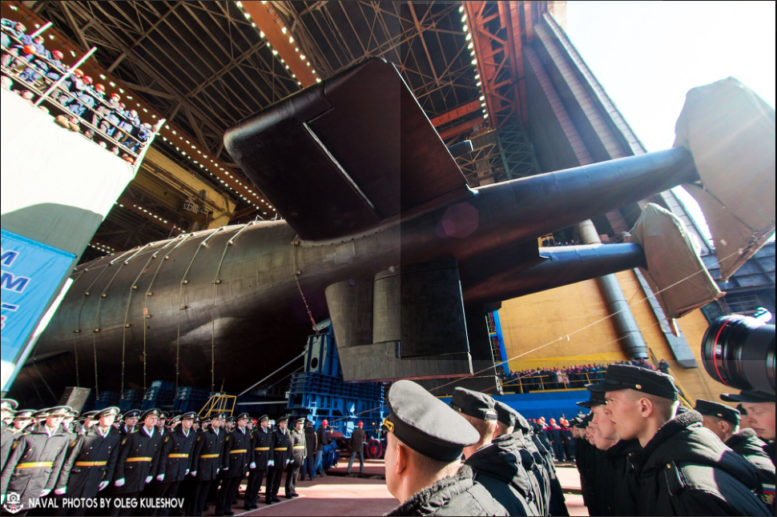Russia’s Sevmash Shipyard launched the special-purpose submarine Belgorod (KS-139) at Severodvinsk in a restricted ceremony held on 23-April-2019. The Kremlin hid most of Belgorod from public view during the launch.
Belgorod started construction in July 1992 and was initially to be part of the Project 949AM submarines, also known as the Oscar II-class guided missile submarine. In 2012, the decision was made to convert Belgorod to a unique “special-mission” submarine designated as Project 09852. Belgorod will reportedly be capable of carrying up to 6 nuclear-powered and nuclear-armed Status-6 Torpedoes. The 24-meter long torpedo-looking “drone” known as Kanyon, or more widely known as Poseidon, can field a 100-megaton nuclear warhead while achieving a maximum speed of 185 km/h (115 mph). The system is still under development.
Belgorod will carry other special purpose mini-submarines, like those on the Kola Peninsula where Russia’s Main Directorate for Deep Sea Research, called GUGI, is located. Belgorod’s refit work added nearly 100 feet to the sub’s overall length. It is now a 184-meter nuclear powered submarine, 11 meters longer than the giant 173-meter Soviet-era Typhoon-class ballistic missile submarines of the Cold War, and 29 meters longer than the Oscar-II class sub. It is now the world’s longest submarine.
According to Barents Observer in March 2019 when Russia’s Defense Minister Sergey Shoigu visited Sevmash Shipyard, the Belgorod would be the first full-time carrier of the Poseidon, a nuclear-powered, nuclear-armed underwater drone. The Poseidon, a torpedo-looking drone, is powered by a small nuclear reactor, and designed as a second nuclear strike weapon. If an enemy targets Russia with nuclear weapons, it will retaliate. Launched from Belgorod, the drone tipped with a multimegaton nuclear warhead, can traverse oceans in depth and silence, and is impossible to stop. Poseidon will be a game-changer for global nuclear deterrence when it becomes operative.
Belgorod is built on an extended hull of what was originally meant to be an Oscar-II class multi-purpose submarine, a sister vessel to the ill-fated Kursk submarine that sank in the Barents Sea during a naval exercise in August 2000. The hull of the submarine was laid down in 1992. Twenty years later, the Russian Defense Ministry decided to use the hull to construct a giant special purpose vessel in 2012. The extra space in the elongated hull has room to carry deep-sea operations equipment, such as a small-sized nuclear reactor that can provide power for secret military installations on the Arctic Sea bed.
The “special mission” designed for the Belgorod is likely to be covert placement of large underwater systems, like the new multi-sensor submarine detection network named Harmony. The Russian network has sensors aimed at detecting enemy submarines.
Harmony would be powered by nuclear reactors that would likely be placed on the Arctic shelf by Belgorod.
Belgorod is inherently linked to Poseidon that reportedly has an effective unlimited range, and design features that make it quite difficult to detect. Poseidon is meant to give Russia a second-strike deterrent capability –completely and entirely immune to U.S. missile defenses. Thus, it is called Russia’s doomsday machine. In February 2019, the Russian Ministry of Defense released a video of underwater testing of the weapon.
The confirmed existence of Poseidon suggests that Belgorod could launch the nuclear-powered Harpsichord 2P-PM minidrone submarine from a hangar on top of the hull. The Harpsichord could carry additional sonar and sensors to help scout ahead of Belgorod, and any manned midget submarine. Harpsichord is capable of deep diving unmanned operations, and can precisely hold station over objects of interest – a feature Belgorod is likewise aiming for – the ability to hover over an object in a relatively stable position underwater.
The Sevmash Shipyard will continue outfitting work on the Belgorod pier side, do mooring tests, launch the 2 reactors, and perform sea trials before its projected 2020 delivery.
References:
- Nilsen, Thomas. “Here comes a nuclear submarine longer than the world has ever seen.” The Barents Observer, 23-April-2019
- Trevitchick, Joseph and Rogoway, Tyler. “Analyzing the first images of Russia’s huge doomsday torpedo carrying special missions sub.” The War Zone, 24-April-2019.
- “Russia launches Poseidon-capable ‘special-mission’ submarine Belgorod.” Naval Today, 24-April-2019.
